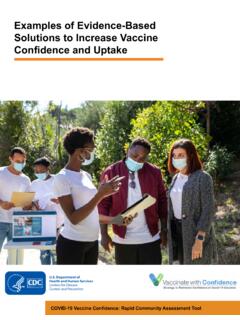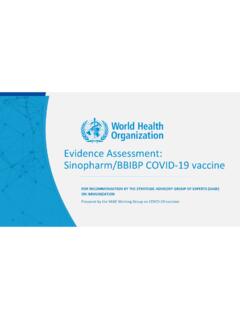Transcription of Increasing COVID-19 Vaccine Uptake among Racial and …
1 Increasing COVID-19 Vaccine Uptake among Members of Racial and Ethnic Minority Communities: A Guide for Developing, Implementing, and Monitoring Community-Driven Strategies US Department of Health and Human Services/Centers for Disease Control and Prevention/National Center for Immunization and Respiratory Diseases January 28, 2021 1 Purpose: The COVID-19 Vaccination Supplemental Funding to IP19-1901 requires use of 10% of total funding for high-risk and underserved populations. This guide aims to support immunization awardees in establishing a community-driven approach and work plan for developing, implementing, and monitoring strategies to increase Vaccine Uptake among communities of focus.
2 The guide focuses on Racial and ethnic minority communities as an example due to the disproportionate burden of COVID-19 among these groups, but it is applicable to other communities that are hard to reach, experience marginalization or discrimination, and/or demonstrate Vaccine hesitancy. This guide may be supplemented with additional materials and resources as more is learned about effective strategies and interventions. When finalized, CDC-RFA-1P21-2108, Partnering with National Organizations to Support Community-Based Organizations to Increase Vaccination Coverage Across Different Racial and Ethnic Adult Populations Currently Experiencing Disparities, can help support the partner network described in this guide; planned partnerships and organizations to be funded are still in development.
3 Background: Medical and structural racism and discrimination have led to mistrust of the medical system among Racial and ethnic minority D ata consistently show health disparities among Racial and ethnic minorities relative to white populations, including vaccination coverage among adults. These disparities persist even when controlling for other demographic, socioeconomic, and structural D isparities in vaccination are associated with lack of both access to vaccination and Vaccine acceptance. Historical events, such as the Tuskegee Syphilis Study, and current lived experiences of racism and discrimination contribute to significant distrust among Racial and ethnic minority groups of both vaccines and vaccination providers, as well as the institutions that make recommendations for the use of This skepticism extends to COVID-19 Vaccine .
4 It is compounded by the unprecedented speed with which COVID-19 vaccines were State data compiled by the Kaiser Family Foundation shows that COVID-19 vaccination rates for Black and Latinx populations are lower than their share of the population and their share of COVID-19 cases and deaths in some Current Vaccine hesitancy among members of Racial and ethnic minorities is strong despite the disproportionate impact of COVID-19 on these groups, particularly in Black and Latinx communities. Black or African American, non-Hispanic persons are times, and Hispanic/Latinx persons are times, more likely to be hospitalized due to COVID-19 than white, non-Hispanic persons, and both populations are times more likely to Even so, only 42% of Black Americans say they would get a COVID-19 vaccination if As Black and Latinx communities have faced a disproportionate burden of COVID-19 , it is paramount that Vaccine confidence and trust are strengthened in these communities.
5 Figure 1: Statistics on the impacts of COVID-19 in Black and Hispanic/Latinx communities 2 A Community-Driven Approach for Increasing COVID-19 Vaccine confidence and Uptake : To build Vaccine confidence and increase Uptake among members of Racial and ethnic minority communities, immunization awardees can establish or bolster existing partnerships with community organizations, leaders, and other local partners to define barriers and assist in development and implementation of strategies offering them a seat at the table, providing support to help implement strategies, and continuously engaging their knowledge, insights, and lived experiences as a part of planning and engagement.
6 This guidance provides a community-driven approach to i dentifying partners and Increasing Vaccine confidence and Uptake using five steps, as seen in Figure 2 and the summary below. Step 1: Use data to identify and prioritize Racial /ethnic minority communities that may be less likely to receive a COVID-19 Vaccine . Step 2: For each community of focus, identify relevant government officials and community partners to form a community partner network. Step 3: Work with the community partner network to understand barriers in the community and create an implementation plan for vaccination messaging, outreach, and administration.
7 Step 4: Help community partner networks implement plans, providing funding and support as needed. Step 5: Conduct continuous program evaluation through data collection and analysis to inform possible changes to the ongoing strategies. Figure 2: Community-driven approach 3 Step 1: Use data to identify and prioritize Racial /ethnic minority communities that may be less likely to receive a COVID-19 Vaccine To identify Racial /ethnic minority communities that may be less likely to get vaccinated and could benefit from additional support to develop tailored, community-based strategies, immunization awardees may wish to explore existing data sources.
8 An identified community of focus should be a specific Racial /ethnic minority group in a specific geographic area ( , specific Black community residing in a specific part of the city). Potential data sources are provided in Table 4 in Appendix A. These data sources can either inform the location of Racial /ethnic minority communities or provide insight into challenges around access to vaccination services or the prevalence or likelihood of Vaccine hesitancy. Immunization awardees may have access to other local data sources that may be informative, including qualitative or anecdotal data on attitudes, beliefs, and lived experiences related to either COVID-19 or other vaccines among members of Racial /ethnic minority communities.
9 In addition, CDC plans to support immunization awardees through data-informed technical assistance a service that gives immunization awardees hands-on support in using data to identify priority communities and develop strategies to build Vaccine confidence . Step 2: For each community of focus, identify relevant government officials and community partners to form a community partner network For each community of focus, immunization awardees can define a community partner network that comprises local public health officials (including health equity directors), community-based organizations and leaders, and community members that serve, represent, and are trusted by the community of focus.
10 See Figure 3 for an example. Across all communities of focus, awardees can identify other key groups for awareness, information-sharing, and coordination; these can include groups receiving COVID-19 Vaccine supply, officials with experience in community programs ( , food banks, homeless shelters, HIV prevention programs), healthcare agencies or systems ( , Medicaid agencies and their managed care organizations), first responders, or other groups. Figure 3: Community partner network example for Black and Hispanic/Latinx Communities 4 Once the community partner network for a community of focus is created, awardees can: Engage one or more local officials and health equity officers as local leads these leads can help identify and plan outreach to community-based organizations and leaders, especially new contacts, given their networks and proximity.











